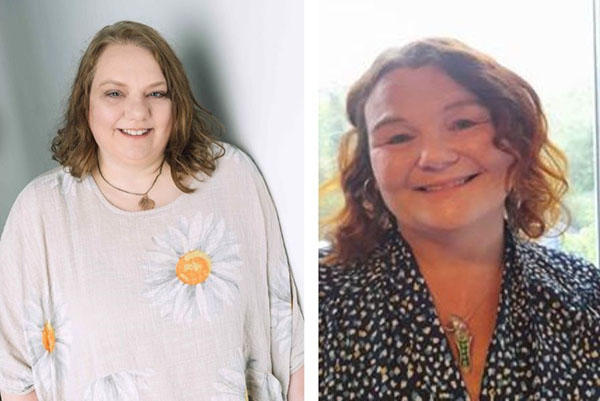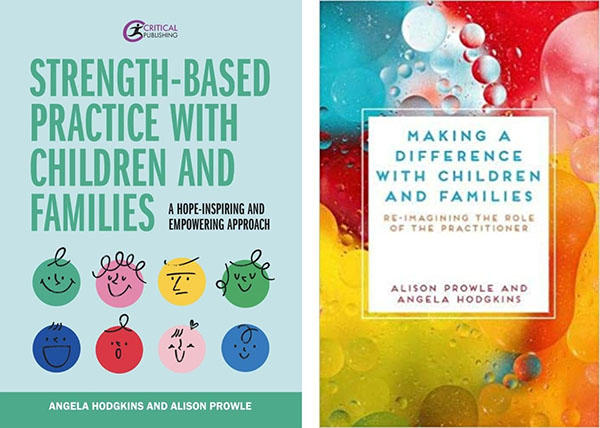Angela Hodgkins and Alison Prowle are senior lecturers in the Department for Children and Families within the Institute of Education. They are passionate about the strength-based approach to working with children and families and published a book about it in September 2023, Strength-based Practice with Children and Families.

A strength-based, hope-inspiring approach
Our strength-based view is that whatever struggles, adversities and challenges exist, there are always strengths and there is always hope. A family living in poverty and struggling with financial hardship may have a close loving relationship which sustains them; a child with a severe disability may have a talent or skill that they get immense pleasure from; a family experiencing bereavement may use their experience to support others in a positive way.
Positive attitude
This modern fable is an example of a positive attitude:
Many years ago, two salesmen were sent abroad by a shoe manufacturer to investigate and report back on market potential. The first salesman reported back, ‘There is no potential here – nobody wears shoes.’ The second salesman reported back, ‘There is massive potential here – nobody wears shoes.’ (Author unknown)
The fable illustrates that whatever happens in life, we can choose how to respond to it. A positive attitude is more likely to lead to positive change for the better.
In 1995, a horse jumping accident changed the life of actor Christopher Reeve forever. He went from a fit and healthy, well- loved actor famously portraying Superman on screen, to someone paralysed from the neck down needing assistance to breathe. His positive attitude meant that he remained hopeful, and he worked to raise awareness and improve the lives of people living with disability until his death in 2004. Reeve’s philosophy was based on his strength and determination to make a difference.
I think a hero is an ordinary individual who finds the strength to persevere and endure in spite of overwheling obstacles.
Christopher Reeve
Resilience
A strength-based approach is not about being positive and joyful all of the time, it is also about building resilience. Resilience is the ability to ‘bounce back’ from adversity and it is a cornerstone of strength-based practice. Resilience can be learned and practised. Consider Dvorsky et al’s (2019) five C’s of building resilience in children and young people:
- Competence – children need opportunities to develop skills and be seen to be succeeding
- Confidence – children should be nurtured in experiencing success through age-appropriate activities
- Connection – children need to feel the security of a group or community, so they know they are not alone
- Character – children need an understanding of right and wrong and the capacity to make ethical decisions
- Caring – helping others makes it easier for children to ask for help if they need it; asking for help is important in developing resilience
Helping children to develop resilience is a skill that will sustain them for life.
Reframing
All to often, we tend to focus on people’s negative qualities, particularly when talking about children. Labelling a child as ‘naughty’ or ‘bossy’ can have a negative effect and can lead to low self-worth. Adults around the child may lower their expectations of the child. Children learn by absorbing their surroundings and the words we use around them are incredibly powerful. Rather than focusing on a child’s behaviour as a problem to be dealt with, we advocate reframing aspects of a child’s personality in a positive light.
Here are some examples:
| Instead of... | Try saying... |
|---|
| Anxious, scared of everything |
thoughtful and careful |
| Bossy |
has good leadership qualities |
| Attention seeking |
able to communicate needs, seeks connection |
| Silly behaviour |
fun-loving, good sense of humour |
| Hyperactive |
energetic, enthusiastic |
| Fussy |
has strong preferences |
| Tattletale |
seeks justice, respects rules |
| Stubborn |
persistent, determined |
Hope for the future
We live in uncertain times, with the climate emergency, cost of living crisis, war in Europe and the Middle East, and recovery from the recent Covid-19 pandemic. Hopefulness is more important than ever, helping us to imagine a better future and helping us to believe we have the tools to achieve it. Here are our strategies for the future:
- Start with achievable goals
- Move beyond wishing into imagining and action
- Think about which aspects are under your control
- Pay attention and focus
- Seek help from others and build communities
Sometimes, a reason for hope is not immediately visible, so we need to actively seek out opportunities for hope and optimism, especially in challenging circumstances. We can then model hopeful solutions and collaborate with those who can help us work towards positive outcomes.
Be aware of your own strengths and remember, the glass is half full.
Books by Angela and Alison

Hodgkins, A. and Prowle, A. (2023) Strength-based Practice with Children and Families. St Albans: Critical Publishing.
Prowle, A. and Hodgkins, A. (2020) Making a Difference with Children and Families: Re-imagining the Role of the Practitioner. London: Bloomsbury Publishing.
Bibliography
Dvorsky, M. R. et al. (2019) Factor Structure and Criterion Validity of the Five Cs Model of Positive Youth Development in a Multi-University Sample of College Students. Journal of Youth and Adolescence 48(3): 537-553.
Mattis, E. (2021) 5 Strategies for Cultivating Hope this Year. The Conversation [Online]. Available at: https://theconversation.com/5-strategies-for-cultivating-hope-this-year-152523 (Accessed 19 June 2023).
All views expressed in this blog are the Academic’s own and do not represent the views, policies or opinions of the University of Worcester or any of its partners.